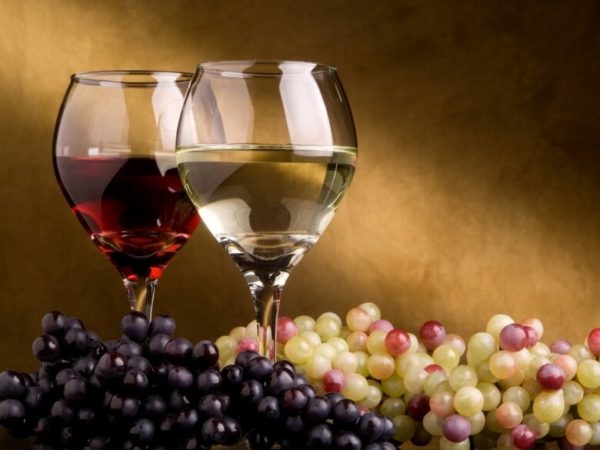Some gardeners manage to make wine from almost all available grapes. However, the technology of wine production involves the use of certain varieties of culture, filled with a whole bunch of flavors. The most popular wine white and blue varieties are discussed in this article.
Table of contents
The best wine grapes
The grapes from which juices and wine are made are called technical. The characteristic of grapes looks modest in comparison with table types:
- medium and small sizes with densely spaced fruits;
- the average brush weight is 120-150 g .;
- high content of juice (75-85% by weight of the berry);
- the sugar content exceeds 18%.
Wine grapes fruit steadily well. This contributes to the increased resistance of plants to fungal infections and pest attacks. Next, find out which variety is best suited for winemaking.
The best white varieties for winemaking
Chardonnay
Chardonnay - a worldwide known technical variety of Western European origin. Thoroughly clarify the pedigree is not possible, but it is believed that the species appeared due to the crossing of pinot noir and hue blanc.
Berries are processed for the production of wines with different flavors, fruit aroma. Also, part of the crop is sent annually for the production of wine materials, which are subsequently used as a champagne taste improver.
Brief description of the plant:
- the bush is formed srednerosly, although there are vigorous and vigorous;
- the growing season lasts 130-140 days;
- flowers bisexual, which provides good pollination;
- conical clusters are friable, weight reaches 900-1000 grams;
- white-green berries are shaded by a golden sheen;
- fruit shape - rounded, slightly elongated;
- grape weight - 12-15 gr., each contains 2-3 seeds;
- sugar content - 18% with an acidity of 8-12 g / l;
- yield - 8-12 t / ha;
- the culture is frost-resistant, withstands temperatures up to minus 20 °.
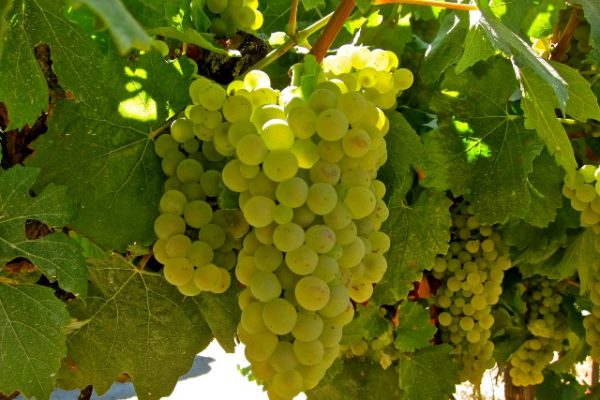
Bianca
Wine materials from Bianchi has an unsurpassed taste with hints of vanilla, almonds. For the production of table, semi-sweet and other wines, blending with other juices with a low sugar content is used. This helps to avoid cloying, which is characteristic of this grape.
Brief description of the plant:
- early term of ripening, vegetation period - 110-120 days;
- medium bush;
- brush cylindrical shape, weight 90-120 g .;
- fruits are small and medium, weight 1.5 g;
- the shape of the berries is round, slightly elongated, the color is greenish-yellow;
- thin skin, taste harmonious, filled with a bouquet of aromas;
- the crop does not lose its presentation on the vine after full maturity;
- sugar content - 20-28% with an acidity of 7-9 g / l;
- high resistance to mildew, gray rot, oidium, tolerance to phylloxera;
- frost resistance - up to minus 27 °.
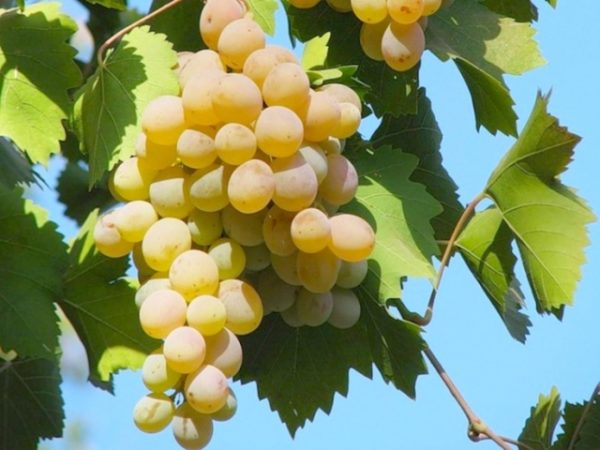
Muscat
Muscat early ripening with a growing season of 130-140 days. Muscat is one of the most ancient varieties originating from Syria, Arabia and Egypt. The peculiarity of the culture is the ability to accumulate a high level of sugar (up to 25% with an acidity of 6.5-7 g / l).
A brief description of:
- medium sized shrub;
- weight of a conical shape is 100-450 g .;
- berries sit tightly on the hand, the average weight of one is 4 grams;
- the taste is full of nutmeg;
- productivity - 66-109 centners per hectare;
- resistance to disease is low.
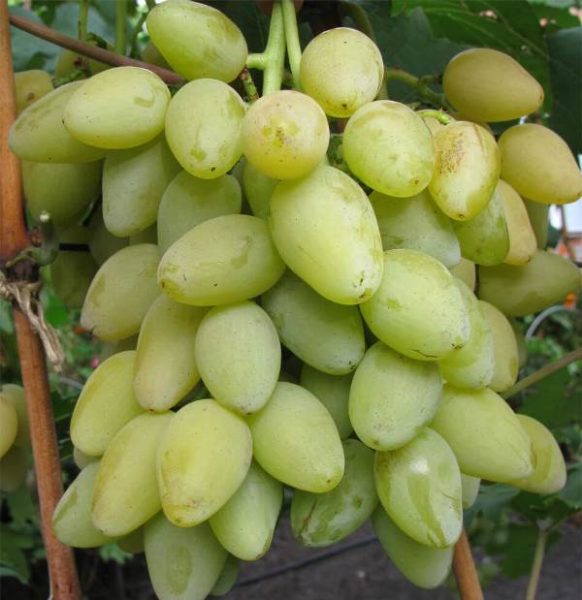
Sauvignon Blanc
The variety was obtained by crossing Chenin Blanc and Taminer. Thanks to the great taste, balance of sugar and acid, grapes have been recognized worldwide. The peculiarity of culture is the timely harvest. When overriding, the berry loses its properties and taste, becomes unsuitable for winemaking.
A brief description of:
- vegetation period 130-135 days;
- bushes sredneroslye, but powerful enough with a developed root system;
- clusters of small size, weight is 75-120 grams;
- berry is small, color is greenish-white with a wax coating (each contains 2-3 seeds);
- low yield;
- sugar content - 18-23% with an acidity of 6.7-11 g / l.
Culture shows weak resistance to oidium and gray rot, tolerance to mildew. In conditions of growth with high humidity, there is a shedding of flowers. Soils are preferred with a content of clay interlayers, as well as gravel and sandy inclusions.
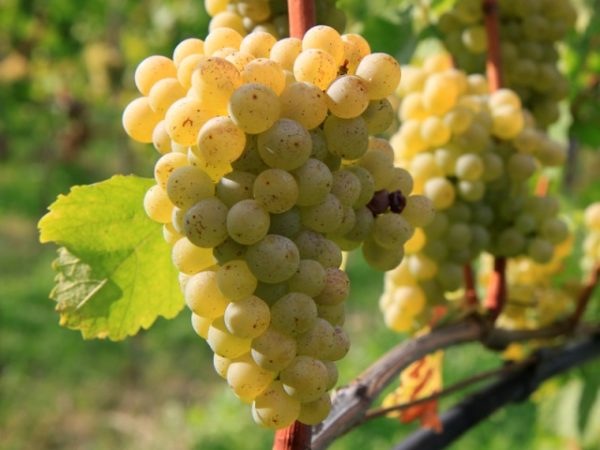
Riesling
The variety, donated by nature itself, is considered king in winemaking. From the berries with excellent taste, which is filled with different notes and shades, high-quality wines are made.
A brief description of:
- growing season - 140-150 days;
- clusters are dense, weight is 80-100 gr .;
- yellow-green berries with a bluish tinge, weight 1.3-1.5 g., rounded shape;
- the skin is thick but thin;
- frost resistance to minus 20 °;
- full ripening occurs in October-November;
- sugar content of 18% with an acidity of 9-11 g / l;
- disease resistance is low.
Fruit grapes on different soils, but more acceptable is the land containing lime.
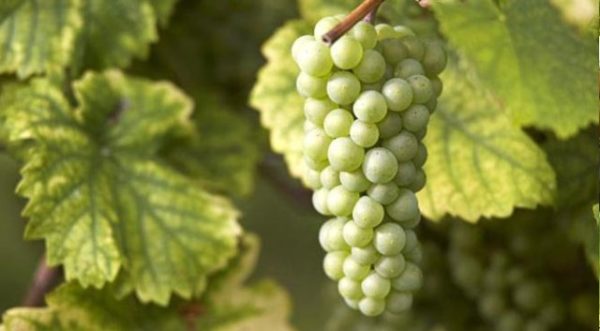
Pinot blanc
A representative of the Pinot family is characterized by many-sided taste, it is used to make still, sparkling and dessert wines. Burgundy is the birthplace of the plant, but today almost all European countries and other regions can boast of high yields.
A brief description of:
- growing season - 140-150 days;
- clusters of average density weighing 85-150 gr .;
- berries are rounded yellow-green in color, weight 1.4-1.7 g;
- the average sugar content reaches 20%.
The peculiarity of the variety is the low content of acid and aromatic substances, as a result of which Pinot Blanc is recommended for making wine that young people need to use.
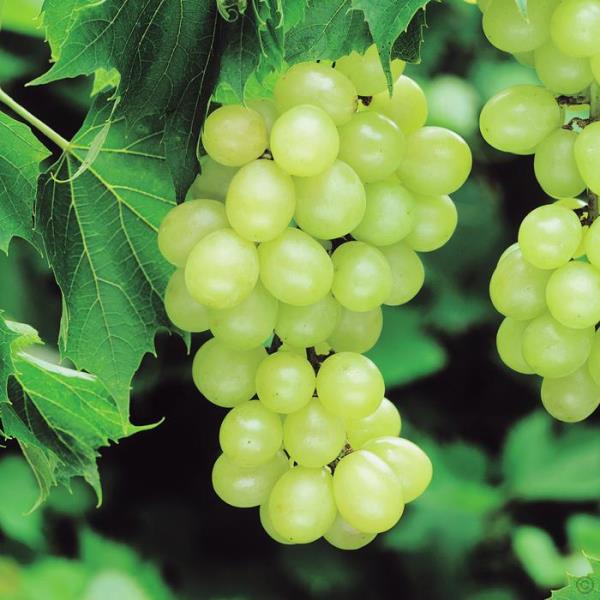
What are the best varieties for red wine
Pinot noir
Black productive grapes ripen in 141-151 days. There is no reliable information about the origin, but Traminer and Pino Mene are probable parents. Bush srednerosly with an unusual color of the lower leaves (green with a red tinge). Flowers bisexual, problems with pollination does not arise. A cluster of small sizes weighing 66-120 grams, the shape is often cylindrical. Berry has a pleasant taste, colorless juice, balanced sugar content. Its shape is rounded, the color is dark blue.
The yield of Pinot Noir - 50-60 c / ha. The plant is vulnerable to phylloxera, manifested tolerance to gray rot, oidium.
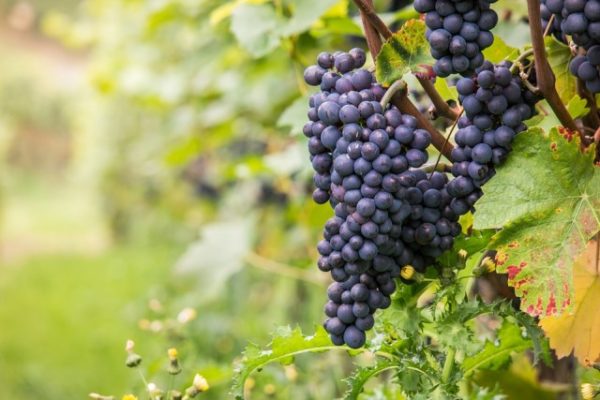
Saperavi
Very old Georgian grape variety with dark blue berries. Vegetation period saperavi - 150-160 days, the harvest begins in late September - early October. The bush is beautifully hung with wide-conic clusters with small grapes, the mass of one is 90-100 grams. Berry is very juicy with a harmonious taste, the weight barely exceeds 1 gr. Each contains 2-3 seeds.
The yield of Saperavi is 90-110 c / ha. The culture is frost-resistant, going through the winter without shelter at a temperature regime not exceeding -20 °.

Cabernet Sauvignon
Berries cabernet sauvignon very juicy with a balanced taste, shaded by a hint of currant. Variety bred in France, but is now cultivated in many countries around the world. Technical ripeness occurs in 143-165 days. The cluster has the shape of a cylinder, the weight is 70-80 grams. Each berry contains 1-3 seeds. The skin is a dark blue color of medium density, which ensures good preservation and transportability of fruits.
Productivity - 55-60 c / ha. There is an increased resistance of the culture to mildew, gray rot. In comparison with other species, it is better opposed to phylloxera, the attacks of the wheller.
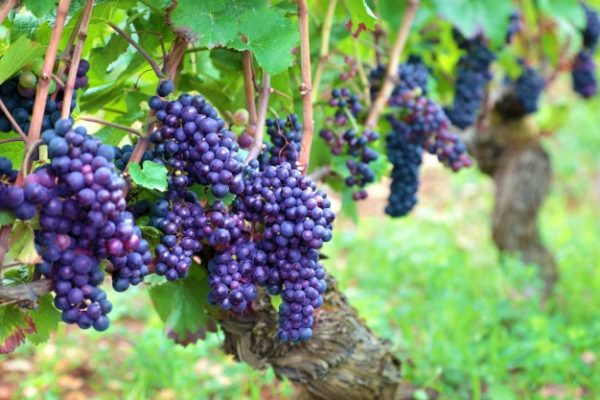
Cabernet Franc
Technical ripeness occurs in 145-160 days. The unusual taste of the berries is filled with different notes, in which there is raspberry and blackberry.The clusters of a cylindrical shape have a dark blue color, the weight does not exceed 70-90 grams. The yield is low (35-40 centners per hectare), but this is offset by the good resistance of the plant to mildew, phylloxera.
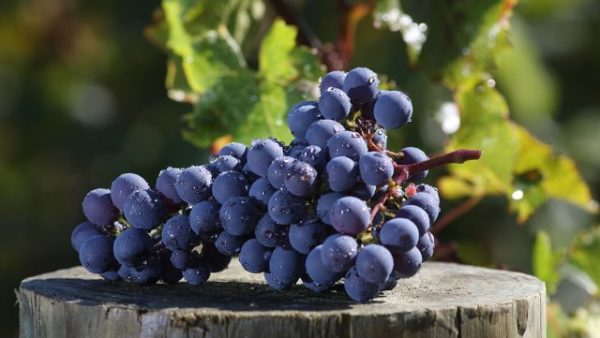
Merlot
Variety merlot Bred in France, Cabernet Franc, crossed with Magdalen and Noir de Charente, are supposed parents. Clusters of medium size and density, have a dark blue color with a characteristic wax coating, weight is 110-150 grams. The taste is balanced with a hint of hair.
Grapes ripen in 152-164 days. The plant shows average resistance to oidium, phylloxera, mildew. Frost resistance - up to minus 15-17 °.
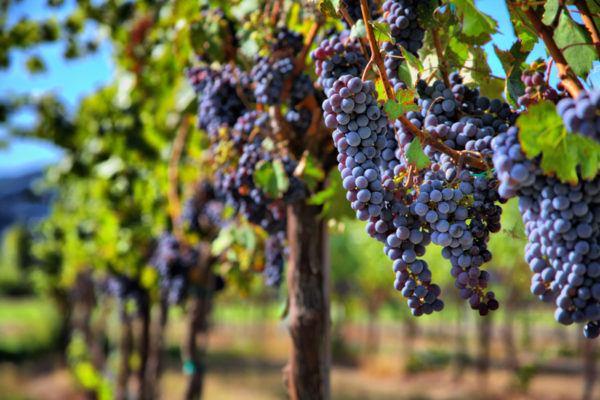
Sangiovese
Italian thermophilic technical grape variety with a growing season of 145-160 days. Shrubs sredneroslye, flowers bisexual, clusters of cylindrical medium density, weighing up to 100 grams. There are many clones that have several other parameters of the berries (0.7 - 1.3 gr.). Taste of fruit saturated with different notes gives refinement to any drink.
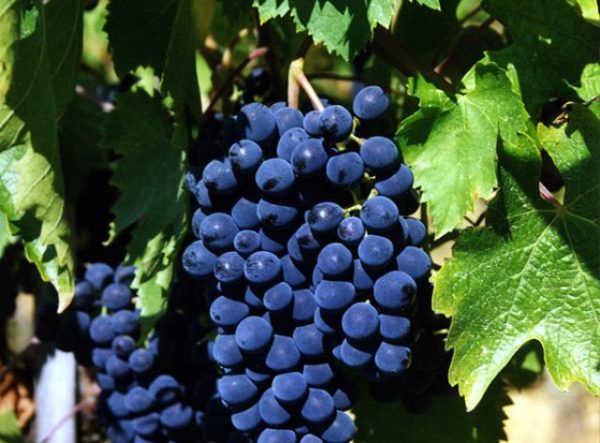
Syrah
The variety is resistant to cold and high temperatures, but does not tolerate strong winds and drought.Tastes meet the requirements of technical varieties of grapes, but can not boast a high yield (30 kg / ha). The juice of the fruits of adult plants is saturated with a beautiful dark purple hue and density. The term of ripening is 145-158 days. The weight of the wide conical bunch is within 80-120 g.
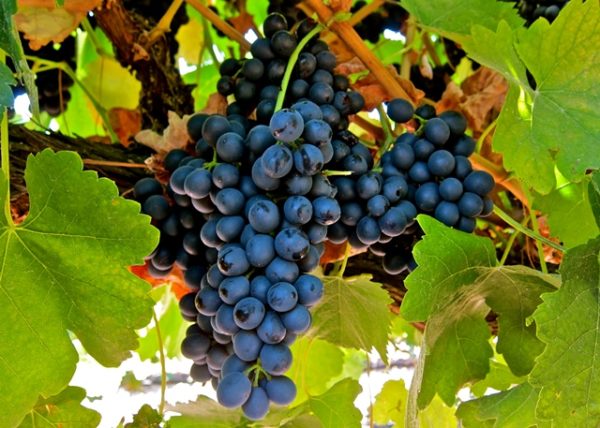
Carmener
Grapes belong to the ancient French varieties with a growing season of 152-165 days. Currently large-scale cultivated mainly in Chile, is considered the pride of the country. The bushes are vigorous plants, the bunch can be in the form of a cylinder, wide-conical and shapeless, the weight is 75-100 grams.
A medium-sized berry hardly curtains by 1 gr., But the pulp is very tasty, sweet, but without cloying. Beautiful dark purple color makes it possible to produce wines from pink to dark color.
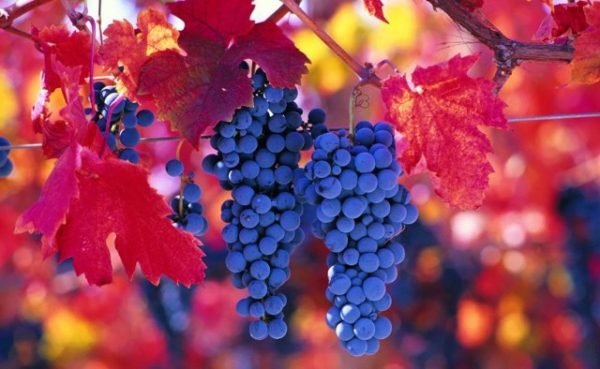
Mourvedre
The plant is a late term of maturation, originally from Spain.Shrubs are well developed, have a powerful vine and root system. The leaves are medium in size with a characteristic three-blade shape. Dark blue berries are more often rounded, but can take a slightly oval shape, the parameters are average. Yield with weak irrigation - up to 60 kg / ha, but with regular irrigation can increase significantly. Clusters are formed in the form of a cone or cylinder, the berries are tightly pressed to each other.
The culture has a weak resistance to fungal infections, but it tolerates a rather long-lasting drought, and the soil type does not have high requirements for planting.

Grenache
Universal variety, but most often the fruits are used for the manufacture of grapes and juice. Variety is one of the most common on the planet due to the adaptability of the vine. The grapes are very thermophilic, easily tolerate drought and heat. The soil also does not have high requirements for planting seedlings. Productivity in arid conditions is high - up to 20 c / ha. Features of the berries: low acid level, juiciness, ruby color, rich aroma.
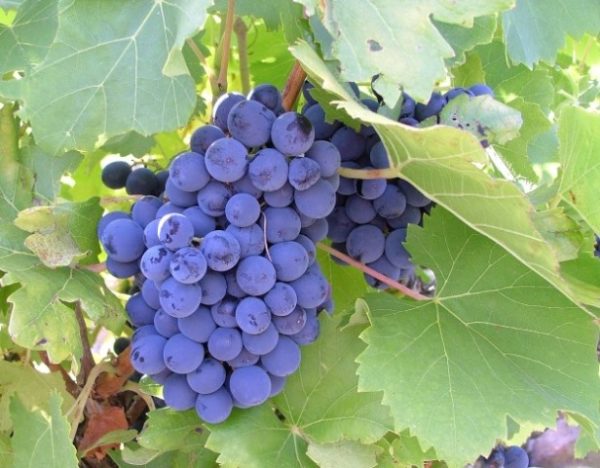
Each variety has unique qualities that give the wine a unique shade and aroma.Before choosing a variety, it is necessary to clarify the compatibility of wine materials with juices of other varieties, then at home you can create an exquisite drink, and most importantly - an exclusive one, the taste of which will remain for a long time in memory.
